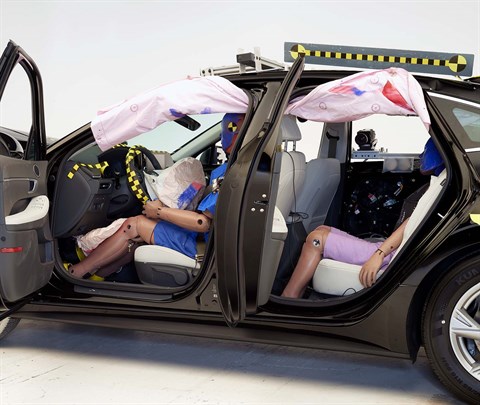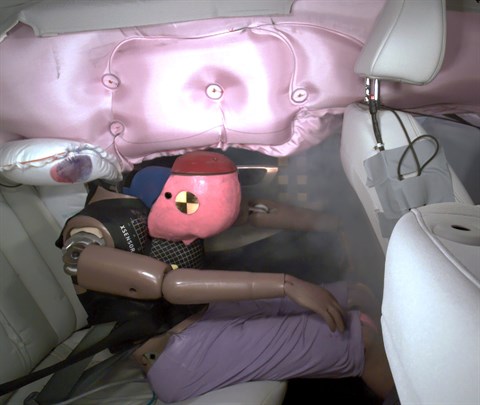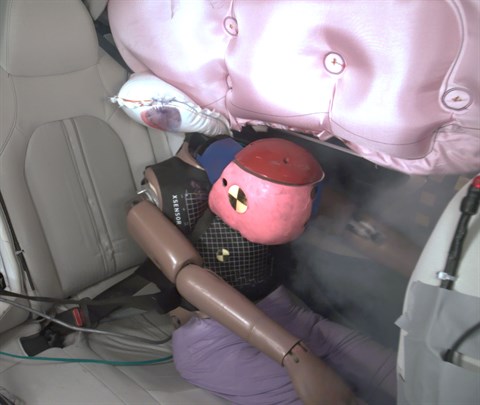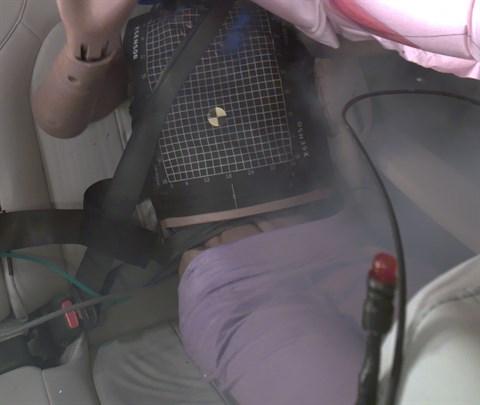Small overlap front
The small overlap front evaluation consists of a driver-side and a passenger-side component. If the results of the two evaluations differ, then the combined small overlap rating is equal to the lower rating.
Driver-side
- Rating applies to 2020-24 models
Tested vehicle: 2020 Hyundai Sonata SE 4-door
The Hyundai Sonata was redesigned for the 2020 model year. Driver-side small overlap frontal ratings are assigned by the Institute based on a test conducted by Hyundai as part of frontal crash test verification.
| Overall driver-side evaluation | |
|---|---|
| Structure and safety cage | |
| Driver injury measures | |
| Head/neck | |
| Chest | |
| Hip/thigh | |
| Lower leg/foot | |
| Driver restraints and dummy kinematics | |
Measures of occupant compartment intrusion on driver side
| Test ID | VTN1916 |
|---|---|
| Lower occupant compartment | |
| Lower hinge pillar max (cm) | 2 |
| Footrest (cm) | 4 |
| Left toepan (cm) | 3 |
| Brake pedal (cm) | 4 |
| Parking brake (cm) | |
| Rocker panel lateral average (cm) | 0 |
| Upper occupant compartment | |
| Steering column | 0 |
| Upper hinge pillar max (cm) | 2 |
| Upper dash (cm) | 2 |
| Lower instrument panel (cm) | 2 |
Driver injury measures
| Test ID | VTN1916 |
|---|---|
| Head | |
| HIC-15 | 96 |
| Peak gs at hard contact | no contact |
| Neck | |
| Tension (kN) | 0.8 |
| Extension bending moment (Nm) | 15 |
| Maximum Nij | 0.16 |
| Chest maximum compression (mm) | 26 |
| Femur (kN) | |
| Left | 0.7 |
| Right | 0.1 |
| Knee displacement (mm) | |
| Left | 0 |
| Right | 1 |
| Knee-thigh-hip injury risk (%) | |
| Left | 0 |
| Right | 0 |
| Maximum tibia index | |
| Left | 0.61 |
| Right | 0.45 |
| Tibia axial force (kN) | |
| Left | 2.6 |
| Right | 0.5 |
| Foot acceleration (g) | |
| Left | 50 |
| Right | 43 |
Passenger-side
- Rating applies to 2020-24 models
Tested vehicle: 2020 Hyundai Sonata SE 4-door
The Hyundai Sonata was redesigned for the 2020 model year. Passenger-side small overlap frontal ratings are assigned by the Institute based on a test conducted by Hyundai as part of frontal crash test verification.
| Overall passenger-side evaluation | |
|---|---|
| Structure and safety cage | |
| Passenger injury measures | |
| Head/neck | |
| Chest | |
| Hip/thigh | |
| Lower leg/foot | |
| Passenger restraints and dummy kinematics | |
| Driver injury measures | |
| Head/neck | |
| Chest | |
| Hip/thigh | |
| Lower leg/foot | |
| Driver restraints and dummy kinematics | |
Measures of occupant compartment intrusion on passenger side
| Test ID | VTP1934 |
|---|---|
| Lower occupant compartment | |
| Lower hinge pillar max (cm) | 3 |
| Footrest (cm) | 4 |
| Right toepan (cm) | 3 |
| Center toepan (cm) | 1 |
| Rocker panel lateral average (cm) | 0 |
| Upper occupant compartment | |
| Center dash (cm) | 2 |
| Upper hinge pillar max (cm) | 2 |
| Upper dash (cm) | 2 |
| Right lower dash (cm) | 3 |
Passenger injury measures
| Test ID | VTP1934 |
|---|---|
| Head | |
| HIC-15 | 78 |
| Peak gs at hard contact | no contact |
| Neck | |
| Tension (kN) | 0.7 |
| Extension bending moment (Nm) | 14 |
| Maximum Nij | 0.17 |
| Chest maximum compression (mm) | 25 |
| Femur (kN) | |
| Left | 0.1 |
| Right | 0.7 |
| Knee displacement (mm) | |
| Left | 0 |
| Right | 1 |
| Knee-thigh-hip injury risk (%) | |
| Left | 0 |
| Right | 0 |
| Maximum tibia index | |
| Left | 0.34 |
| Right | 0.58 |
| Tibia axial force (kN) | |
| Left | 0.5 |
| Right | 3.4 |
| Foot acceleration (g) | |
| Left | 47 |
| Right | 66 |
Driver injury measures
| Test ID | VTP1934 |
|---|---|
| Head | |
| HIC-15 | 57 |
| Peak gs at hard contact | no contact |
| Neck | |
| Tension (kN) | 0.7 |
| Extension bending moment (Nm) | 8 |
| Maximum Nij | 0.16 |
| Chest maximum compression (mm) | 21 |
| Femur (kN) | |
| Left | 0.2 |
| Right | 0.6 |
| Knee displacement (mm) | |
| Left | 1 |
| Right | 2 |
| Knee-thigh-hip injury risk (%) | |
| Left | 0 |
| Right | 0 |
| Maximum tibia index | |
| Left | 0.23 |
| Right | 0.41 |
| Tibia axial force (kN) | |
| Left | 0.4 |
| Right | 1.5 |
| Foot acceleration (g) | |
| Left | 18 |
| Right | 32 |
Moderate overlap front: original test
Rating applies to 2020-24 models
Tested vehicle: 2020 Hyundai Sonata SEL 4-door
The Hyundai Sonata was redesigned for the 2020 model year. Moderate overlap frontal ratings are assigned by the Institute based on a test conducted by Hyundai as part of frontal crash test verification.
| Overall evaluation | |
|---|---|
| Structure and safety cage | |
| Driver injury measures | |
| Head/neck | |
| Chest | |
| Leg/foot, left | |
| Leg/foot, right | |
| Driver restraints and dummy kinematics |
Measures of occupant compartment intrusion on driver side
| Test ID | VTF1926 |
|---|---|
| Footwell intrusion | |
| Footrest (cm) | 3 |
| Left (cm) | 4 |
| Center (cm) | 5 |
| Right (cm) | 1 |
| Brake pedal (cm) | 5 |
| Instrument panel rearward movement | |
| Left (cm) | 0 |
| Right (cm) | -1 |
| Steering column movement | |
| Upward (cm) | -1 |
| Rearward (cm) | -4 |
| A-pillar rearward movement (cm) | 0 |
Driver injury measures
| Test ID | VTF1926 |
|---|---|
| Head | |
| HIC-15 | 213 |
| Peak gs at hard contact | no contact |
| Neck | |
| Tension (kN) | 0.8 |
| Extension bending moment (Nm) | 9 |
| Maximum Nij | 0.19 |
| Chest maximum compression (mm) | 27 |
| Legs | |
| Femur force - left (kN) | 0.4 |
| Femur force - right (kN) | 1.0 |
| Knee displacement - left (mm) | 0 |
| Knee displacement - right (mm) | 2 |
| Maximum tibia index - left | 0.24 |
| Maximum tibia index - right | 0.43 |
| Tibia axial force - left (kN) | 2.0 |
| Tibia axial force - right (kN) | 2.2 |
| Foot acceleration (g) | |
| Left | 62 |
| Right | 44 |
Moderate overlap front: updated test
Rating applies to 2023-24 models
Tested vehicle: 2023 Hyundai Sonata SE 4-door
The Hyundai Sonata was redesigned for the 2020 model year.
| Overall evaluation | |
|---|---|
| Structure and safety cage | |
| Driver injury measures | |
| Head/neck | |
| Chest | |
| Thigh/hip | |
| Leg/foot | |
| Driver restraints and dummy kinematics | |
| Rear passenger injury measures | |
| Head/neck | |
| Chest | |
| Thigh | |
| Rear passenger restraints and dummy kinematics |
|

View of the vehicle after the crash showing the airbags and damage to the occupant compartment.

The rear passenger dummy's head remained a safe distance from the front seatback.

Rear passenger dummy injury values indicate a likely risk of injury to the head or neck and chest. During the crash, the shoulder belt remained in an ideal position on the dummy’s chest.

The rear passenger dummy's lap belt moved from the ideal position on the pelvis onto the abdomen, increasing the risk of abdominal injuries.
Measures of occupant compartment intrusion on driver side
| Test ID | CEF2311 |
|---|---|
| Footwell intrusion | |
| Footrest (cm) | 3 |
| Left (cm) | 5 |
| Center (cm) | 7 |
| Right (cm) | 2 |
| Brake pedal (cm) | 6 |
| Instrument panel rearward movement | |
| Left (cm) | -1 |
| Right (cm) | -1 |
| Steering column movement | |
| Upward (cm) | 0 |
| Rearward (cm) | -4 |
| A-pillar rearward movement (cm) | 0 |
Driver injury measures
| Test ID | CEF2311 |
|---|---|
| Head | |
| HIC-15 | 254 |
| Peak gs at hard contact | no contact |
| Neck | |
| Tension (kN) | 0.7 |
| Extension bending moment (Nm) | 7 |
| Maximum Nij | 0.18 |
| Chest maximum compression (mm) | 26 |
| Femur (kN) | |
| Left | 0.5 |
| Right | 1.2 |
| Knee displacement (mm) | |
| Left | 1 |
| Right | 2 |
| Knee-thigh-hip injury risk (%) | |
| Left | 0 |
| Right | 0 |
| Maximum tibia index | |
| Left | 0.27 |
| Right | 0.43 |
| Tibia axial force (kN) | |
| Left | 2.9 |
| Right | 3.0 |
| Foot acceleration (g) | |
| Left | 58 |
| Right | 45 |
Rear passenger injury measures
| Test ID | CEF2311 |
|---|---|
| Head | |
| HIC-15 for head contact during forward excursion |
no contact
|
| Peak gs at hard contact | no contact |
| Neck | |
| Tension (kN) | 3.8 |
| Compression (kN) | 0.2 |
| Maximum Nij for head contact during forward excursion |
no contact
|
| Chest | |
| Chest index | 33 |
| Shoulder belt tension (kN) | 7.1 |
| Thigh (kN) | |
| Left femur compression | 1.4 |
| Right femur compression | 0.3 |
Child seat anchors
Rating applies to 2020-24 models
| Overall evaluation |
|
| Vehicle trim | SE |
| Seat type | cloth |
This vehicle has 2 rear seating positions with complete child seat attachment (LATCH) hardware.
It has 1 additional seating position with a tether anchor only.
| Overall evaluation |
|
| Vehicle trim | SE |
| Seat type | cloth |
| G | Good |
| A | Acceptable |
| M | Marginal |
| P | Poor |
|
|
Seating positions that rely on borrowed lower anchors or have only a tether anchor available are not rated. |
|
thether anchor symbol
|
Tether anchor |
|
lower anchor symbol
|
Lower anchors |
| Lower anchor(s) can be borrowed from adjacent positions(s) | |
|
|
No hardware available |
Details by seating position
| 1 | |
|---|---|
| Tether anchor | |
| easy-to-find location | |
| no other hardware could be confused for anchor | |
| Lower anchors | |
| too deep in seat | |
| not too much force needed to attach | |
| easy to maneuver around anchors | |
| 2 | |
| Tether anchor | |
| easy-to-find location | |
| no other hardware could be confused for anchor | |
| Lower anchors | |
| none available | |
| 3 | |
| Tether anchor | |
| easy-to-find location | |
| no other hardware could be confused for anchor | |
| Lower anchors | |
| too deep in seat | |
| not too much force needed to attach | |
| easy to maneuver around anchors |
Seat position 21
| Lower anchor A | |
|---|---|
| Open access rated | No |
| Depth (cm) | 2-4 |
| Force (lbs) | 22 |
| Clearance angle (degrees) | 73 |
| Lower anchor B | |
| Open access rated | No |
| Depth (cm) | 2-4 |
| Force (lbs) | 14 |
| Clearance angle (degrees) | 75 |
| Tether anchor | |
| Location | Rear deck |
| Confusing hardware present | No |
| Has contrasting label within 3 inches of tether anchor |
No |
Seat position 22
| Lower anchor A | |
|---|---|
| No lower latch for this seat position | |
| Lower anchor B | |
| No lower latch for this seat position | |
| Tether anchor | |
| Location | Rear deck |
| Confusing hardware present | No |
| Has contrasting label within 3 inches of tether anchor |
No |
Seat position 23
| Lower anchor A | |
|---|---|
| Open access rated | No |
| Depth (cm) | 2-4 |
| Force (lbs) | 28 |
| Clearance angle (degrees) | 63 |
| Lower anchor B | |
| Open access rated | No |
| Depth (cm) | 2-4 |
| Force (lbs) | 21 |
| Clearance angle (degrees) | 63 |
| Tether anchor | |
| Location | Rear deck |
| Confusing hardware present | No |
| Has contrasting label within 3 inches of tether anchor |
No |
